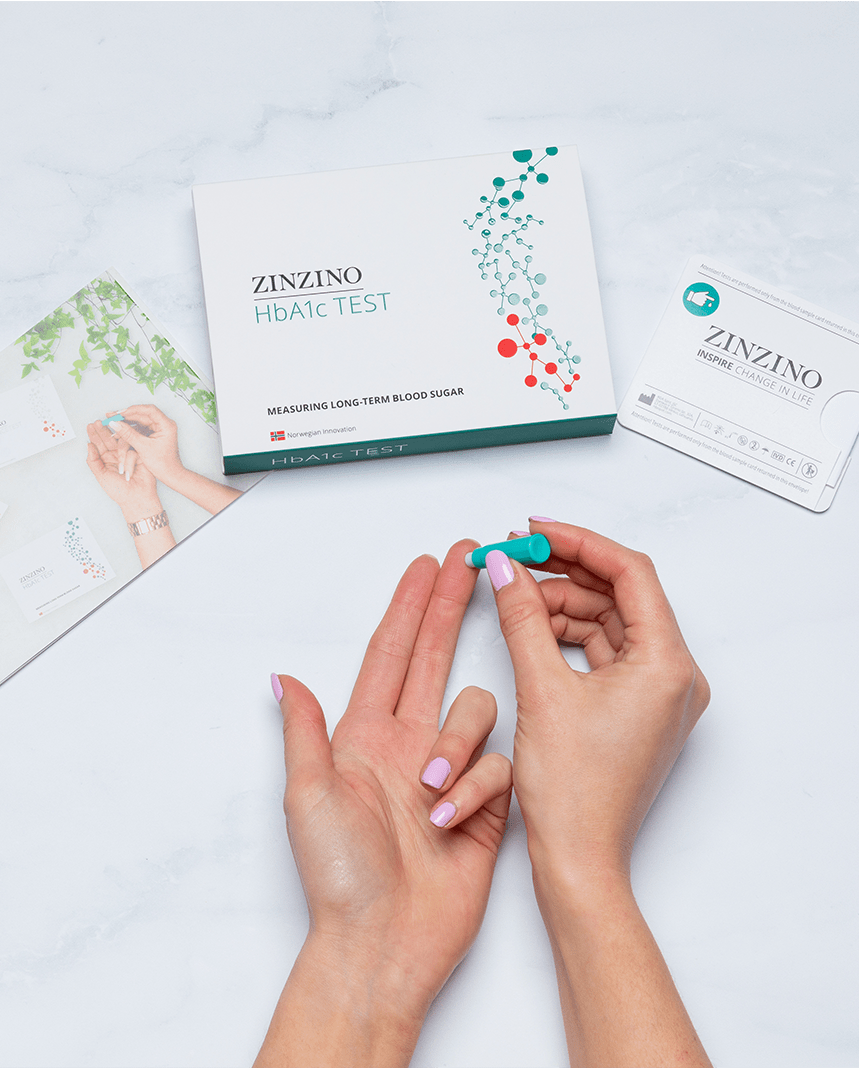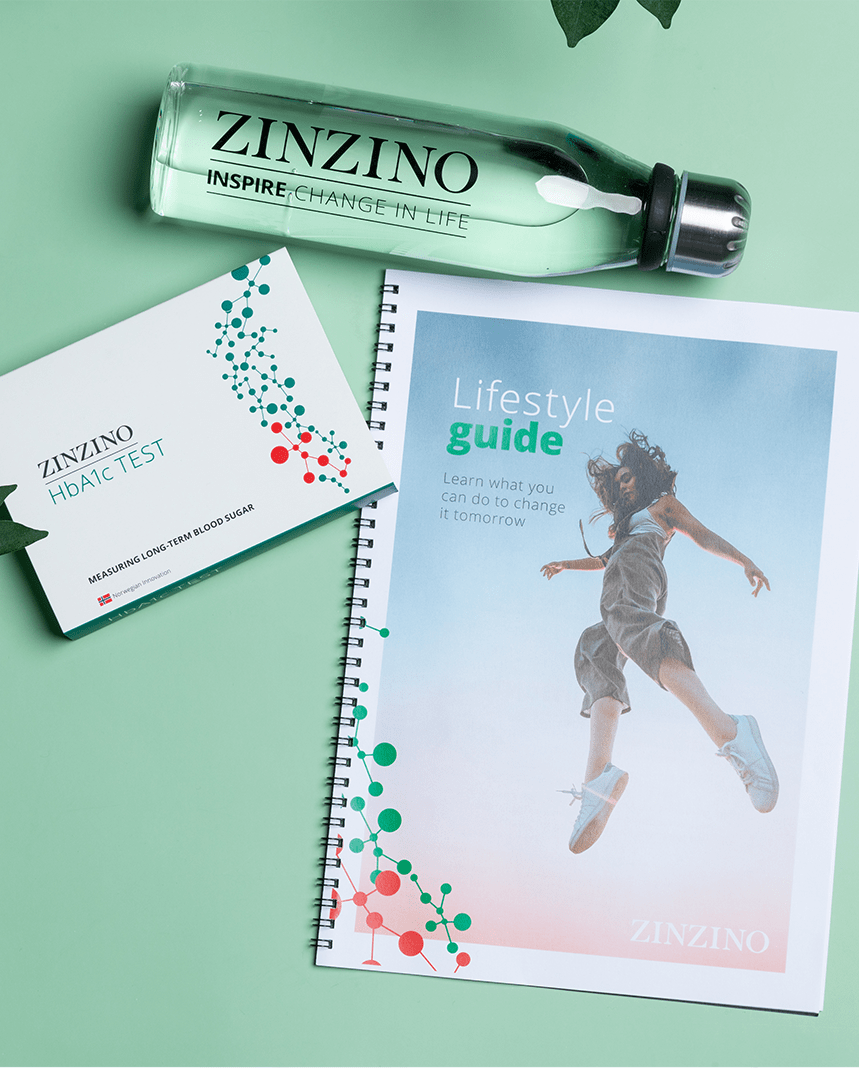Antje Hinz
Zinzino Independent Partner
Welcome! I'm your independent consultant, here to guide you on your health journey. Let me know what you need!
What Is the Hemoglobin A1c (HbA1c) Test?

The hemoglobin A1c or HbA1c test is a reliable and convenient way to measure average blood glucose levels over the past 3 months. This test looks at a marker for blood sugar exposure over time, not at the actual sugar level in your blood. The test score is based on the percentage of glycated hemoglobin over total hemoglobin in red blood cells. It is essentially a look back in time, giving it a clear clinical advantage over other tests, monitoring your average blood glucose levels over approximately a 90-day period. Unlike other blood metabolic testing, an HbA1c test requires no fasting. For clinicians and patients alike, a single test result will measure if you are in a prediabetic or diabetic range conveniently, and accurately.
What Is HbA1c?
The key to calculating A1c is the protein hemoglobin, the powerhouse of the red blood cell. Hemoglobin’s main purpose is to take up oxygen and carry it throughout your body. As it happens, glucose also sticks to hemoglobin, and it’s naturally present in the bloodstream at some level. As hemoglobin is being created over time, available glucose will bind to a portion of hemoglobin molecules. The higher the level of sugar present at the moment of hemoglobin synthesis, the higher percentage of glycated hemoglobin, or HbA1c, is detected in the test. Because red blood cells have a known, average lifespan of about 3 months, calculating HbA1c becomes a great way to create a snapshot in time of average blood glucose levels1.
Why Should You Complete an HbA1c Screening?
Metabolic disorders like diabetes and prediabetes can remain under the surface and undetected for years, and they often have no symptoms. A diabetes test is the best way to detect a problem before harm can be done. The insidious nature of hyperglycemia, or high blood glucose, is that it damages the body over time. Undetected, high blood glucose levels are chronically toxic to your body. They can lead to oxidative stress impacting multiple organs, accelerate the development of full diabetes and it may shorten your lifespan2. Once a problem is detected, regular A1c testing becomes essential to controlling and monitoring your blood glucose. Knowing where you’ve been and where you are is important. Creating a future of healthy blood glucose to help lead a heather and fuller lifestyle.
Why Is Self-Blood Glucose Monitoring Important?
Everyone’s metabolic health is different, and in the management of hyperglycemia, knowledge is power. Blood sugar control is a matter of having knowledge of your HbA1c level taken over time. But how often do we go to the doctor for a blood test? Self-blood glucose monitoring is essential to manage this condition. Regular glucose monitoring delivers feedback on the adjustments you make to diet and lifestyle, and what works and does not work, to lower blood glucose. Knowing for yourself how well your A1c is controlled is empowering and puts the world’s most involved expert on your health in charge: you.
Is HbA1c the Same as a Diabetes Test?
Yes and no. The HbA1c test can be a single-point diagnostic test for diabetes, or your doctor may wish to repeat a second test to confirm the diagnosis. However, the current diagnostic criteria do allow your healthcare provider to diagnose either prediabetes or diabetes from a single HbA1c test. Further testing may be required to confirm a diagnosis or to determine whether it is type 1 or type 2 diabetes3. As with any health concern, you should always consult your doctor or health care practitioner for a complete diagnosis and preventative plan.
Testing Blood Sugar at Home
More and more health-conscious people are blood sugar self-testing at home. At-home monitoring of blood glucose has become a convenient and effective way of keeping an eye on one’s metabolic health and preventing diabetes. Glycated hemoglobin tests, once relegated to the doctor’s office visit, are now widely available to the public. But to simply measure one’s HbA1c level doesn’t answer the key questions of how we got there. The quality of HbA1c tests is not always consistent. Unfortunately, not all tests are created equal.


Zinzino’s at-Home A1c Test Kit
The Zinzino HbA1c Test kit has two components, a blood sugar self-test and a lifestyle questionnaire. Taking less than a minute to complete, the simple Zinzino finger stick allows a few drops of blood to be collected on a dried blood spot card. Secondly, a comprehensive lifestyle questionnaire is included. That questionnaire is confidential and helps us complete a full health picture. It also lets us provide a future framework for suggested lifestyle changes for health-savvy individuals like yourself.
How our HbA1c test differs from competitors?
Using an unparalleled approach, the Zinzino HbA1c Test kit delivers accurate data within the context of your unique life. We partner with Vitas Analytical Services A/S, one of the world’s leading quality providers in laboratory testing. The H1bA1c dried blood spot testis made to specification to ensure a very high degree of accuracy and reliability. But in isolation, even the best HbA1c test results only tell half of the story. The Zinzino at-Home HbA1c Test kit combines data with a comprehensive lifestyle assessment, all in one kit. It provides the needed context of lifestyle factors that impact blood glucose, such as diet and exercise, and can point to how blood glucose levels came to be elevated. With the test results, Zinzino will provide personal recommendations on diet, supplementation, exercise, and physical activity. We believe in a holistic approach and world-class support for your journey of discovery and personalized wellness.
1. Human red blood cells
Franco, Robert S. 2012. Measurement of Red Cell Lifespan and Aging. Transfus Med Hemother. 2012 Oct; 39(5): 302–307. “Human red blood cells (RBC), after differentiating from erythroblasts in the bone marrow, are released into the blood and survive in the circulation for approximately 115 days.” https://www.ncbi.nlm.nih.gov/pmc/articles/PMC3678251/ Accessed 31 July 2022
2. Kawahito S, Kitahatah H
Kawahito S, Kitahatah H, Oshita S. 2009 Sep 7. Problems associated with glucose toxicity: Role of hyperglycemia-induced oxidative stress. World J Gastroenterol. 15(33): 4137–4142. “It has been found that oxidative stress is associated with the molecular mechanism of the decreased insulin biosynthesis and secretion, which is the main etiology of glucose toxicity.” https://www.ncbi.nlm.nih.gov/pmc/articles/PMC2738809/ Accessed 31 July 2022
3. Understanding A1C Diagnosis
“Understanding A1C Diagnosis” American Diabetes Association. “The A1C test measures your average blood glucose for the past two to three months. The advantages of being diagnosed this way are that you don't have to fast or drink anything. Diabetes is diagnosed at an A1C of greater than or equal to 6.5%” https://www.diabetes.org/diabetes/a1c/diagnosis Accessed 31 July 2022

Share this page
Or copy link